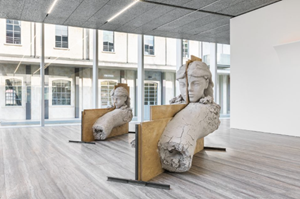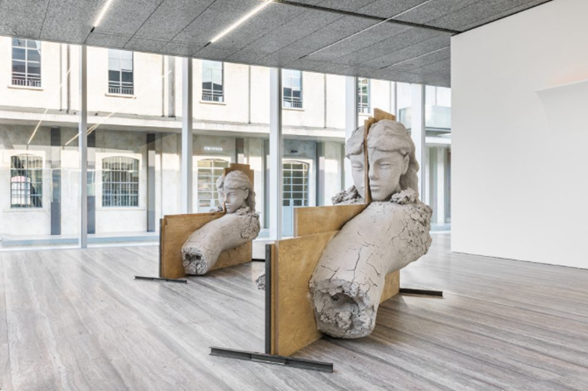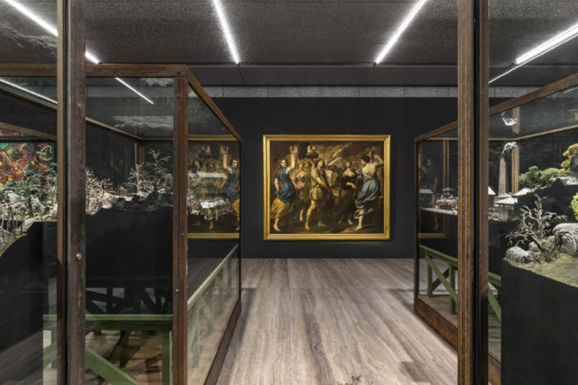
Fondazione Prada presents the exhibition “Sanguine. Luc Tuymans on Baroque”, curated by Luc Tuymans, in its Milan venue. Organized with M KHA (Museum of Contemporary Art of Antwerp) and KMSKA (Museum of Fine Arts of Antwerp) and the City of Antwerp, the project will be featured in Milan in a new and more extensive version, following its first presentation in the Belgian city from June to September 2018.
Image: “Sanguine. Luc Tuymans on Baroque”. Photo: Delfino Sisto Legnani e Marco Cappelletti
Fondazione Prada presents the exhibition “Sanguine. Luc Tuymans on Baroque”, curated by Luc Tuymans, in its Milan venue until 25 February 2019. Organized with M KHA (Museum of Contemporary Art of Antwerp) and KMSKA (Museum of Fine Arts of Antwerp) and the City of Antwerp, the project will be featured in Milan in a new and more extensive version, following its first presentation in the Belgian city from June to September 2018. Luc Tuymans conceived an intense visual experience presenting more than 80 works by 63 international artists, including 25 exhibited exclusively at Fondazione Prada.
“Sanguine” is a personal interpretation of the Baroque based on innovative juxtapositions and unexpected associations of works by contemporary artists and Old Masters. Avoiding a rigid chronological order or a strictly historiographical approach, Tuymans evades the traditional notion of the Baroque and invites viewers to reconsider 17th century art, as well as the contemporary research, by placing artists and their role in society at the center of the exhibition narrative.
 “Sanguine. Luc Tuymans on Baroque”. Photo: Delfino Sisto Legnani e Marco Cappelletti
“Sanguine. Luc Tuymans on Baroque”. Photo: Delfino Sisto Legnani e Marco Cappelletti
In the wake of Walter Benjamin’s analysis, according to whom the Baroque marked the start of modernity, Tuymans explores the search for authenticity, the political significance of artistic representation, the emotional turmoil generated by art, the celebration of the author’s personality, and the international dimension of the art scene, recognizing the Baroque as a primary point of reference for today’s art. Not only does “Sanguine” push the traditional boundaries of the Baroque notion by extending its duration to the present day, but also it shows how over the past two centuries artists have helped redefine it, from the negative sense attributed to the word by art critics during the late 18th century, to the reassessment operated by Postmodernism and the re-establishment of a Baroque and figurative expressiveness in the art of recent years.
The exhibition title—a word that signifies the color of blood, but also a violent and vigorous temperament, and a pictorial technique—suggests a multiplicity of perspectives to interpret the exhibited works, in which violence and its simulation, cruelty and dramatization, realism and exaggeration, disgust and wonder, terror and ecstasy coexist.
 “Sanguine. Luc Tuymans on Baroque”. Photo: Delfino Sisto Legnani e Marco Cappelletti
“Sanguine. Luc Tuymans on Baroque”. Photo: Delfino Sisto Legnani e Marco Cappelletti
In Luc Tuymans’ vision, Caravaggio—who is represented in the exhibition by the painting Boy Bitten by a Lizard (1595-96) and David with the Head of Goliath (post 1606)— was the first to transcend classical and Mannerist tradition thanks to the psychological realism expressed by his innovative pictorial language; he also embodied the spirit of the Baroque artist and the wish to communicate with the public through the power of representation.
The comparison between Caravaggio and Peter Paul Rubens, the Antwerpian portraitist of prominent figures and himself a diplomat, reveals the formal ambiguity characteristic of Baroque painting and the complexity of the relations developed by artists in Europe during the Counter-Reformation and the rise of the merchant class.
The Baroque art of the 17th and 18th centuries was the first global art movement, though it maintained the specific qualities and features of the different local cultures, as well as the sensibilities of the individual artists, represented in the exhibition by Guido Cagnacci, Andrea Vaccaro, Antoon van Dyck, Jacob Jordaens, Francisco de Zurbarán, and Johann Georg Pinsel, among others. In our even more globalized and connected world, suggestions, dynamics and themes typical of Baroque art can be identified in the works by contemporary artists geographically remote from one another and brought together by Luc Tuymans in “Sanguine.”
Sanqine. Luc Tuymans On Baroque
Until 25 February, 2019, Fondazione Prada, Milan

ArtDependence Magazine is an international magazine covering all spheres of contemporary art, as well as modern and classical art.
ArtDependence features the latest art news, highlighting interviews with today’s most influential artists, galleries, curators, collectors, fair directors and individuals at the axis of the arts.
The magazine also covers series of articles and reviews on critical art events, new publications and other foremost happenings in the art world.
If you would like to submit events or editorial content to ArtDependence Magazine, please feel free to reach the magazine via the contact page.